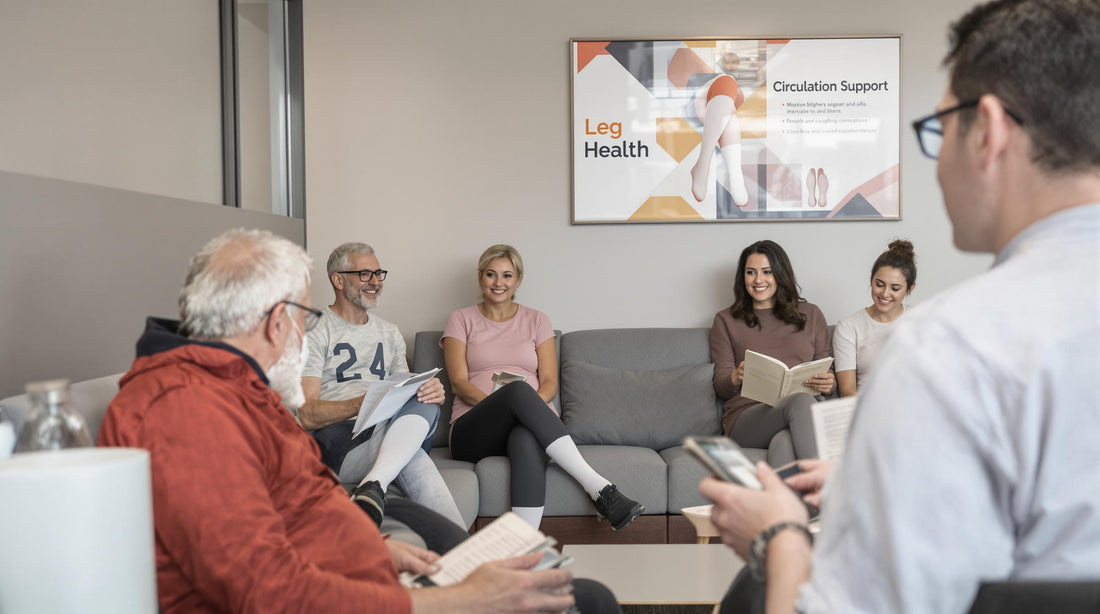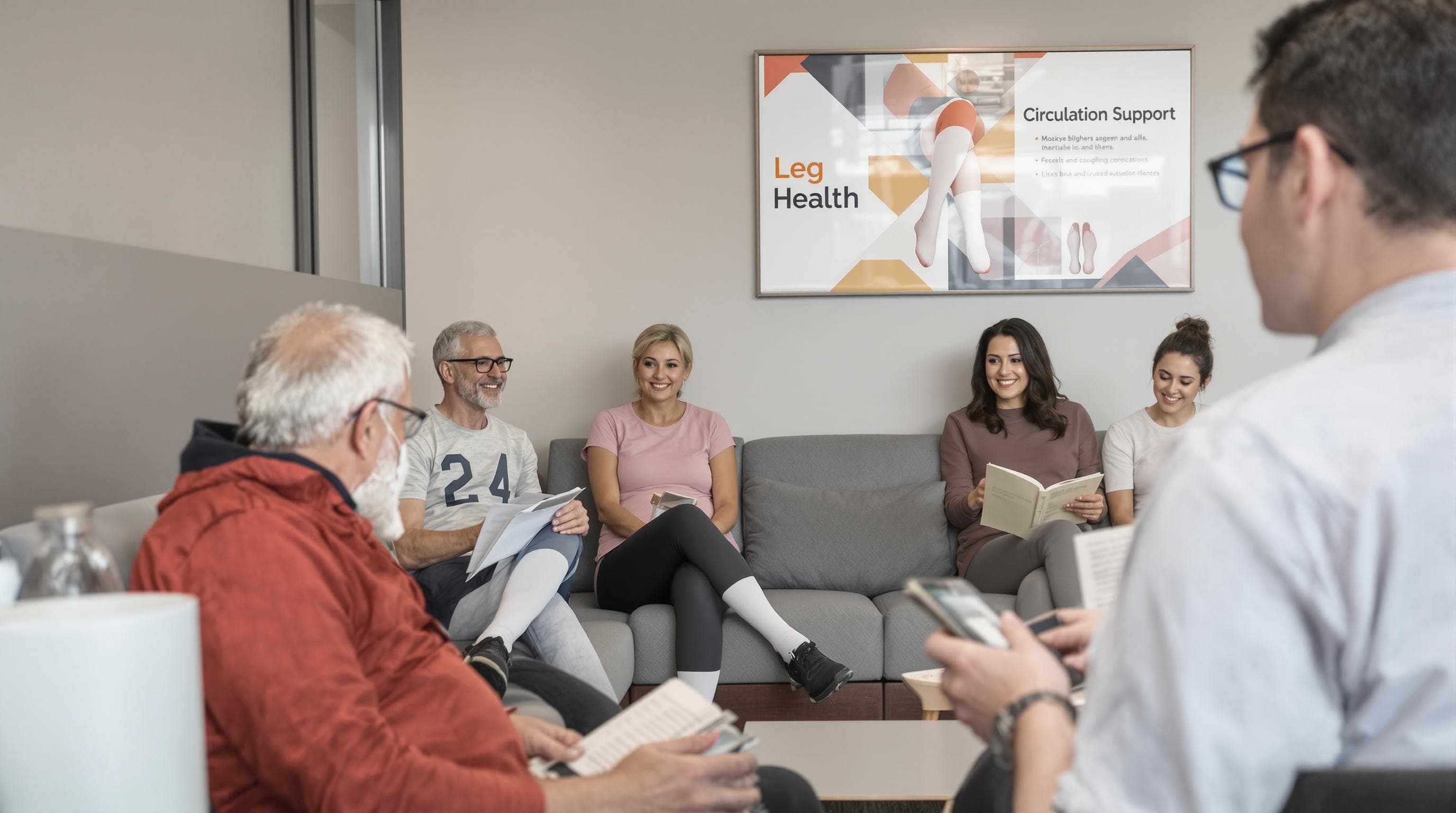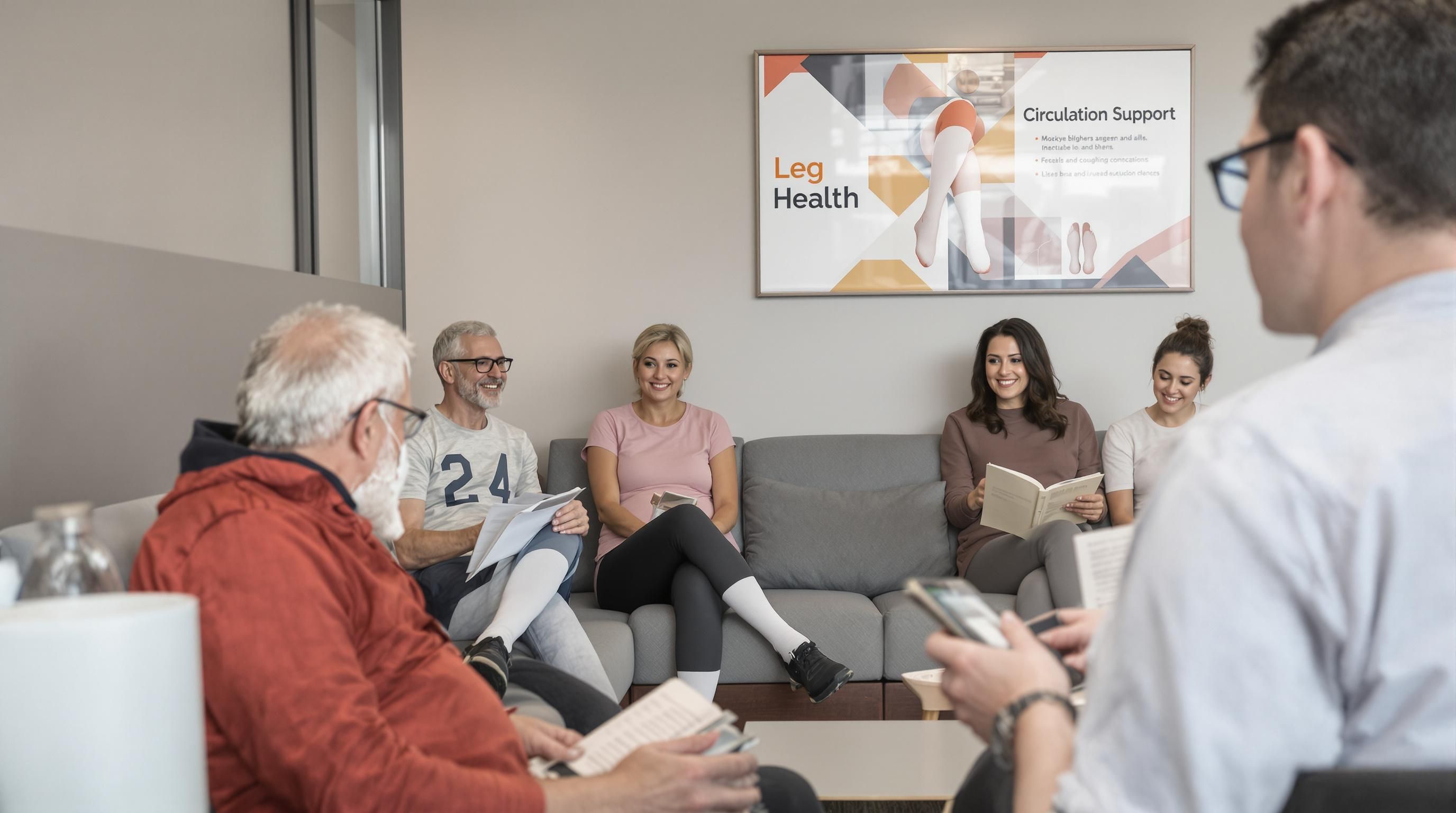
Knee High Compression Stockings: Health Benefits and Guide 2025
Share

Knee high compression stockings are quickly becoming a staple for people who want better leg health and all-day comfort. Here is the wild part. Studies show they can cut deep vein thrombosis risk by up to 60 percent for hospital patients. Most folks just think of them as funny-looking socks for seniors or athletes. That could not be further from the truth.
Table of Contents
Quick Summary
| Takeaway | Explanation |
| Graduated Compression | Knee high compression stockings use graduated compression to optimize blood circulation, with maximum pressure at the ankle and decreasing toward the knee. This aids venous return and reduces blood pooling. |
| Condition-Specific Benefits | These stockings significantly benefit various users, including medical patients by reducing DVT risk, athletes by enhancing recovery, and pregnant women by alleviating leg discomfort and swelling. |
| Selection and Fitting | Choosing the right knee high compression stockings involves understanding compression levels (measured in mmHg) and ensuring proper fit by measuring ankle, calf, and leg length for optimal effectiveness. |
| Proper Care Techniques | To maintain the longevity and functionality of compression stockings, follow care guidelines such as hand washing, air drying, and replacing them every 3-6 months to ensure consistent therapeutic pressure. |
How Knee High Compression Stockings Work
The Science of Graduated Compression
The fundamental principle behind knee high compression stockings is graduated compression, a medical engineering concept that creates strategic pressure variations along the leg. Research from the National Institutes of Health reveals that these stockings apply maximum pressure at the ankle, gradually decreasing as the garment moves upward toward the knee. This intentional pressure gradient creates a powerful physiological response.
When you wear knee high compression stockings, the external pressure compresses superficial veins, accelerating blood flow velocity. By narrowing vein diameters, these stockings essentially create a mechanical assist for your circulatory system. The compression helps push deoxygenated blood back toward the heart, counteracting gravity’s natural downward pull.

Biomechanical Circulation Enhancement
Studies published in the Journal of Vascular Surgery demonstrate that compression therapy can restore valvular competence in refluxing veins. The external pressure helps realign and support venous valve function, which is critical for preventing blood pooling and reducing the risk of conditions like deep vein thrombosis.
The biomechanical process works through several key mechanisms:
-
Vascular Compression: Reduces vein diameter, increasing blood flow speed
-
Muscle Pump Activation: Encourages muscle contractions that support circulation
-
Venous Return Improvement: Assists blood movement against gravitational challenges
These stockings are particularly beneficial for individuals with compromised circulatory systems. Our comprehensive guide on compression therapy provides deeper insights into their medical applications.
The effectiveness of knee high compression stockings depends on precise pressure gradients, typically measured in millimeters of mercury (mmHg). Different medical conditions require specific compression levels, ranging from mild (15-20 mmHg) to medical-grade (30-40 mmHg). Proper fitting is crucial to ensure optimal therapeutic benefits and prevent potential complications.
By understanding the intricate biomechanical principles behind knee high compression stockings, patients can appreciate these garments as more than simple accessories. They represent a sophisticated medical technology designed to support and enhance the body’s natural circulatory processes.
Key Health Benefits for Different Users
Knee high compression stockings offer targeted health benefits across diverse populations, addressing specific physiological needs and medical conditions. Understanding these tailored advantages helps individuals make informed decisions about incorporating compression therapy into their wellness routine.
Benefits for Medical Patients
Research from the National Institutes of Health demonstrates that knee-length graduated compression stockings significantly reduce deep vein thrombosis risk in hospitalized patients. For individuals managing chronic venous disorders, these specialized garments provide critical therapeutic support.
Patients with specific medical conditions experience substantial advantages. Those struggling with diabetes-related circulatory challenges find knee high compression stockings particularly beneficial. Our diabetes support resource explores how these garments help manage peripheral circulation problems, reducing potential complications like ulcers and nerve damage.
Key medical benefits include:
-
Reduced Inflammation: Minimizes swelling in legs and ankles
-
Improved Circulation: Supports blood flow for patients with compromised vascular systems
-
Prevention of Blood Clots: Decreases risk of thrombotic events

Athletic Recovery and Performance
Sports medicine research indicates that compression stockings play a significant role in athletic recovery. While they may not dramatically enhance performance during exercise, these garments offer crucial post-activity benefits.
Athletes and fitness enthusiasts utilize knee high compression stockings to:
-
Accelerate Muscle Recovery: Reduce post-exercise muscle soreness
-
Minimize Muscle Oscillation: Provide stabilization during intense physical activities
-
Support Lymphatic Drainage: Help remove metabolic waste products after workouts
Pregnancy and Lifestyle Support
Pregnant women frequently experience leg swelling, varicose veins, and discomfort. Knee high compression stockings offer a non-invasive solution to manage these challenges. By providing graduated pressure, these garments help prevent blood pooling and reduce the risk of developing varicose veins during pregnancy.
Professionals who spend extended periods standing or sitting also benefit significantly. Jobs requiring prolonged static positions like nursing, teaching, and office work can lead to poor circulation. Compression stockings provide a proactive approach to maintaining leg health and preventing potential circulatory issues.
Beyond medical applications, knee high compression stockings represent a versatile health tool. They bridge the gap between medical intervention and everyday wellness, offering support across various life stages and physical conditions. Whether managing a specific medical concern or seeking preventative care, these garments provide a scientifically backed method of supporting bodily circulation and overall leg health.
Here is a summary table organizing the key health benefits for different user groups as described in this section:
| User Group | Main Benefits |
| Medical Patients | Reduces DVT risk, improves circulation, minimizes swelling |
| Diabetic Patients | Supports peripheral circulation, reduces ulcer risk |
| Athletes | Aids muscle recovery, minimizes oscillation, supports drainage |
| Pregnant Women | Prevents blood pooling, reduces risk of varicose veins |
| Professionals (standing/sitting) | Maintains leg health, prevents circulatory issues |
Choosing the Right Compression Stockings for You
Selecting the appropriate knee high compression stockings requires careful consideration of individual health needs, lifestyle factors, and specific medical conditions. The right pair can significantly enhance circulation and provide targeted therapeutic support.
Understanding Compression Levels
Research from thrombosis specialists emphasizes the critical importance of precise measurements and compression levels. Compression stockings are categorized by mmHg (millimeters of mercury) pressure ratings, which determine their therapeutic effectiveness:
-
Mild Compression (15-20 mmHg): Ideal for daily wear, preventive care, and mild swelling
-
Moderate Compression (20-30 mmHg): Recommended for managing varicose veins and moderate circulatory issues
-
Medical Grade Compression (30-40 mmHg): Prescribed for severe venous conditions and post-surgical recovery
Studies published in medical journals indicate that knee-length graduated compression stockings can be as effective as thigh-length versions, often providing better patient comfort and fewer fitting complications.
Below is a comparison table summarizing the different compression levels, their pressure ranges, and primary use cases:
| Compression Level | Pressure Range (mmHg) | Typical Use Cases |
| Mild Compression | 15-20 | Daily wear, prevention, mild swelling |
| Moderate Compression | 20-30 | Varicose veins, moderate circulatory issues |
| Medical Grade Compression | 30-40 | Severe venous conditions, post-surgery |
| Elderly Use (special) | 18-21 | Mobility issues, arthritis |
Personalized Fitting Considerations
Proper measurement is fundamental to compression stocking effectiveness. Our comprehensive guide on compression stocking selection provides detailed insights into accurate sizing techniques.
Key measurement factors include:
-
Ankle Circumference: Determines base pressure point
-
Calf Width: Ensures consistent compression distribution
-
Leg Length: Guarantees proper coverage and comfort
Geriatric research reveals that elderly patients often benefit from lower interface pressures (18-21 mmHg), especially those with mobility challenges or arthritis.
Special Considerations for Different Users
Different populations require unique compression stocking approaches. Pregnant women might need specific designs that accommodate body changes, while athletes require moisture-wicking materials with targeted muscle support.
Consider these user-specific recommendations:
-
Diabetic Patients: Look for seamless designs to prevent skin irritation
-
Athletes: Seek breathable fabrics with graduated compression
-
Office Workers: Choose lighter compression levels for daily comfort
-
Post-Surgical Patients: Consult healthcare providers for precise medical-grade recommendations
Beyond medical specifications, comfort plays a crucial role. Material composition, elastic quality, and individual body mechanics significantly impact the effectiveness and wearability of knee high compression stockings.
Remember that while compression stockings offer remarkable health benefits, they are not one-size-fits-all solutions. Consulting healthcare professionals ensures you select stockings precisely tailored to your unique physiological needs and health objectives.
Care Tips and Wearing Advice
Knee high compression stockings represent a significant investment in your health, requiring proper care and maintenance to ensure their longevity and continued therapeutic effectiveness. Understanding the nuanced approach to wearing and maintaining these specialized garments is crucial for maximizing their benefits.
Proper Wearing Techniques
Putting on knee high compression stockings demands precision and care. Unlike regular socks, these therapeutic garments require a specific technique to prevent damage and ensure optimal compression. Start by turning the stocking inside out, leaving only the foot portion exposed. Carefully slide your foot into the foot section, then gradually roll the stocking up your leg, smoothing out any wrinkles or folds.
Key considerations for wearing compression stockings include:
-
Morning Application: Put on stockings first thing in the morning when leg swelling is minimal
-
Clean Skin: Ensure legs are completely dry and free from lotions or oils
-
Smooth Application: Use flat hands to distribute the fabric evenly without creating creases
-
Avoid Bunching: Prevent rolling or folding that can interrupt compression effectiveness
Maintenance and Cleaning
Proper cleaning and maintenance are essential for preserving the integrity of your compression stockings. While they require more delicate care than standard socks, maintaining them is straightforward with the right approach. Learn more about our comprehensive care guide for detailed instructions.
Recommended cleaning practices include:
-
Hand Washing: Use lukewarm water and mild soap specifically designed for delicate fabrics
-
Gentle Handling: Avoid wringing or twisting the stockings
-
Air Drying: Lay flat or hang to dry, avoiding direct heat or sunlight
-
Frequency: Wash after 1-2 wears to maintain elasticity and hygiene
Below is a table summarizing the key care and maintenance recommendations to keep your compression stockings in optimal condition:
| Care Task | Recommendation |
| Washing | Hand wash with mild soap in lukewarm water |
| Handling | Do not wring or twist; handle gently |
| Drying | Air dry flat or hang (avoid heat/sunlight) |
| Washing Frequency | After every 1-2 wears |
| Storage | Store flat or rolled, away from heat/sunlight |
Replacement and Longevity
Compression stockings are not permanent medical devices. Their effectiveness diminishes over time due to repeated use and washing. Medical experts recommend replacing knee high compression stockings every 3-6 months, depending on frequency of use and visible wear.
Indications that it is time to replace your compression stockings include:
-
Loss of Elasticity: Reduced ability to maintain consistent pressure
-
Visible Thinning: Fabric appears stretched or worn
-
Visible Damage: Holes, runs, or significant fabric deterioration
-
Reduced Compression: Noticeable decrease in therapeutic pressure
Proper storage is equally important. Keep compression stockings away from direct sunlight, heat sources, and sharp objects. Store them flat or rolled loosely to maintain their shape and elasticity.
Consult with healthcare professionals if you experience any discomfort, skin irritation, or changes in how the stockings fit. Individual needs can change, and periodic reassessment ensures you continue receiving the maximum therapeutic benefit from your knee high compression stockings.
Remember, these garments are more than just accessories. They are precision medical tools designed to support your circulatory health. Treating them with care ensures they continue to provide the support your body needs.
Frequently Asked Questions
What are knee high compression stockings?
Knee high compression stockings are specialized medical garments designed to improve blood circulation in the legs. They apply graduated pressure, being tighter at the ankle and gradually loosening up the leg, which helps with venous return and reduces swelling.
How do knee high compression stockings work?
These stockings create a pressure gradient that supports the natural flow of blood back to the heart, preventing blood pooling in the lower extremities. This mechanism reduces the risk of conditions like deep vein thrombosis (DVT) and improves overall leg health.
Who can benefit from wearing knee high compression stockings?
They are beneficial for a variety of users, including medical patients at risk of venous issues, athletes looking to enhance recovery, pregnant women experiencing leg discomfort, and professionals who spend long periods sitting or standing.
How do I choose the right knee high compression stockings?
Selecting the right stockings involves understanding the compression levels indicated in mmHg (millimeters of mercury) and ensuring a proper fit by measuring your ankle, calf, and leg length. Consult with a healthcare provider for personalized recommendations.
Discover Comfort and Confidence with the Right Knee High Compression Stockings
Do heavy legs, swelling, or worries about circulation frustrate you each day? If you just finished learning how graduated compression can improve vein health and minimize risks like DVT, you deserve a solution that fits your unique needs. At Knee High – Fit Stockings, we bring you a carefully curated selection of medical-grade knee high compression stockings trusted by both patients and professionals. No more guessing about compression levels or worrying about poorly fitted products. Each product page offers real guidance on sizing, compression ranges from 15-20 to 30-40 mmHg, and styles matched to your specific challenges—whether it is managing diabetes, pregnancy discomfort, or recovery needs.

Why wait for better leg health? Browse our Knee High collection today for exclusive choices from premium brands like Jobst, and enjoy fast shipping and easy returns. Take the first step confidently with detailed guides and support at Fit Stockings, your trusted partner for all things compression therapy. Find the pair that helps you feel refreshed and supported, every day.
Recommended
-
The Ultimate Guide to Compression Stockings: What They Are and Who Nee – Fit Stockings
-
How to Choose the Right Compression Stockings for Your Needs – Fit Stockings
-
Top Hyperbaric Oxygen Therapy Benefits for Knoxville Families 2025 - Bell Family Chiropractic
-
SA Diabetic Friendly Foods: 2025 Guide for Healthy Eating - Allulo

